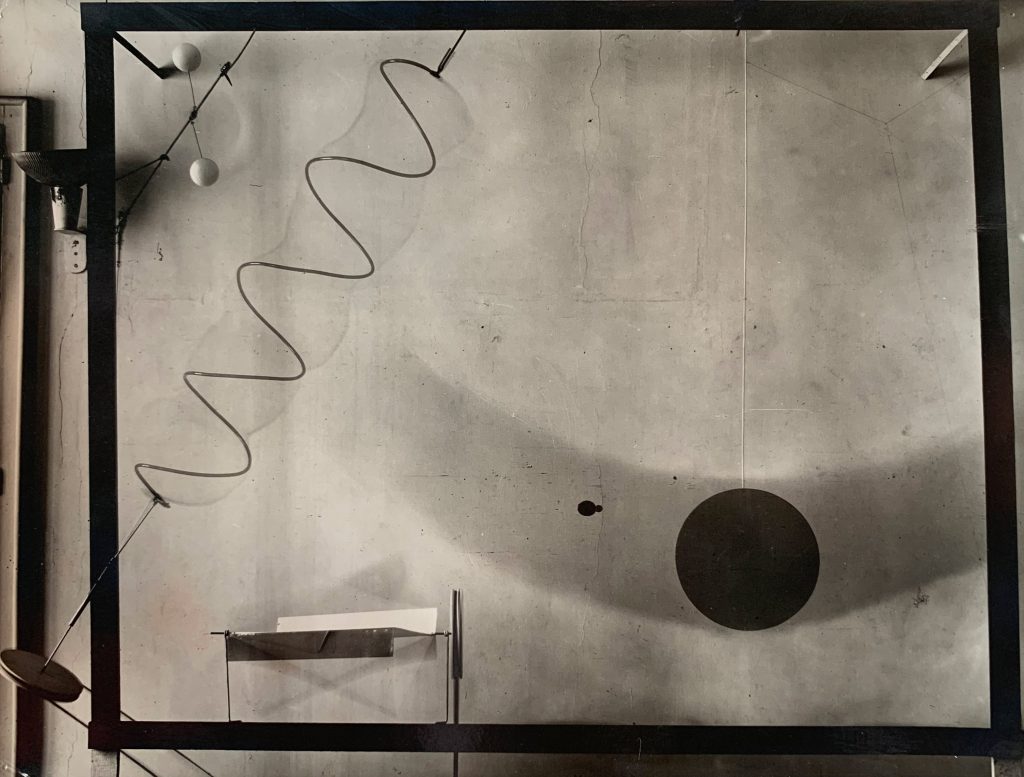
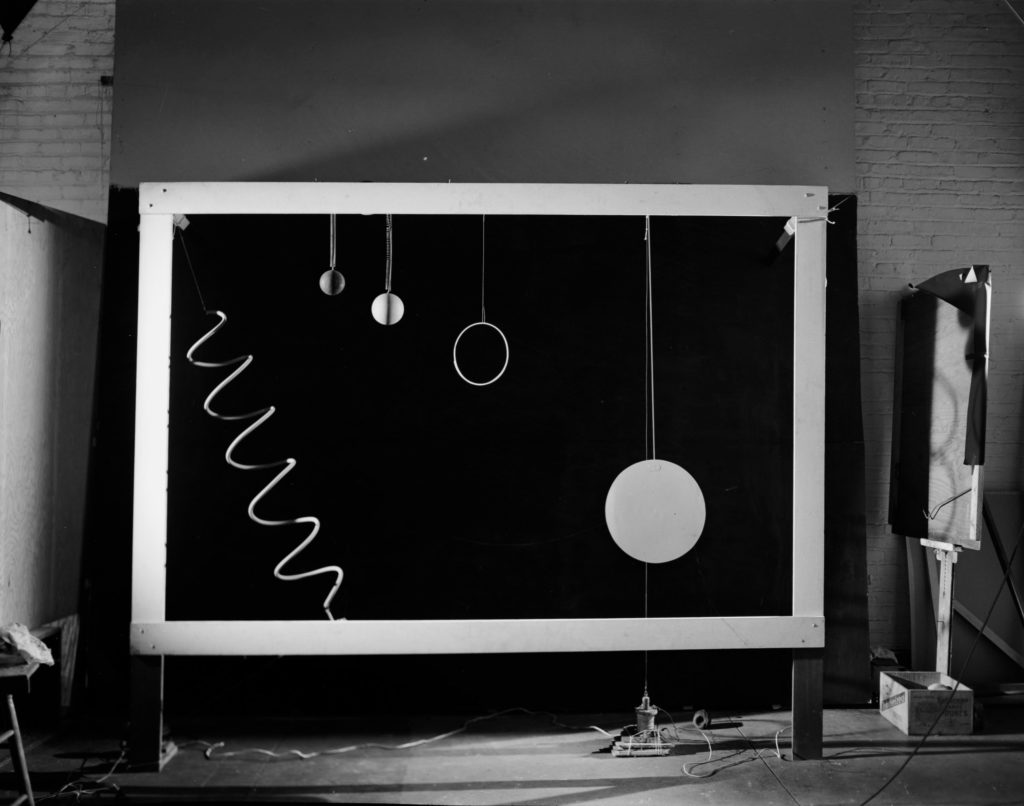
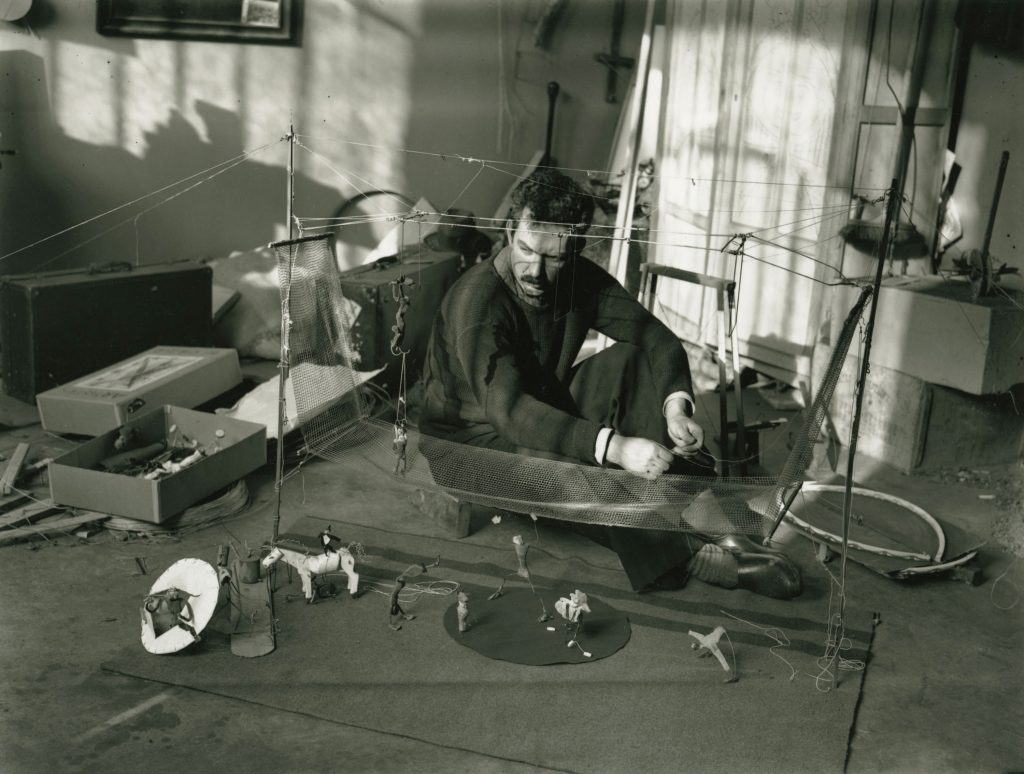
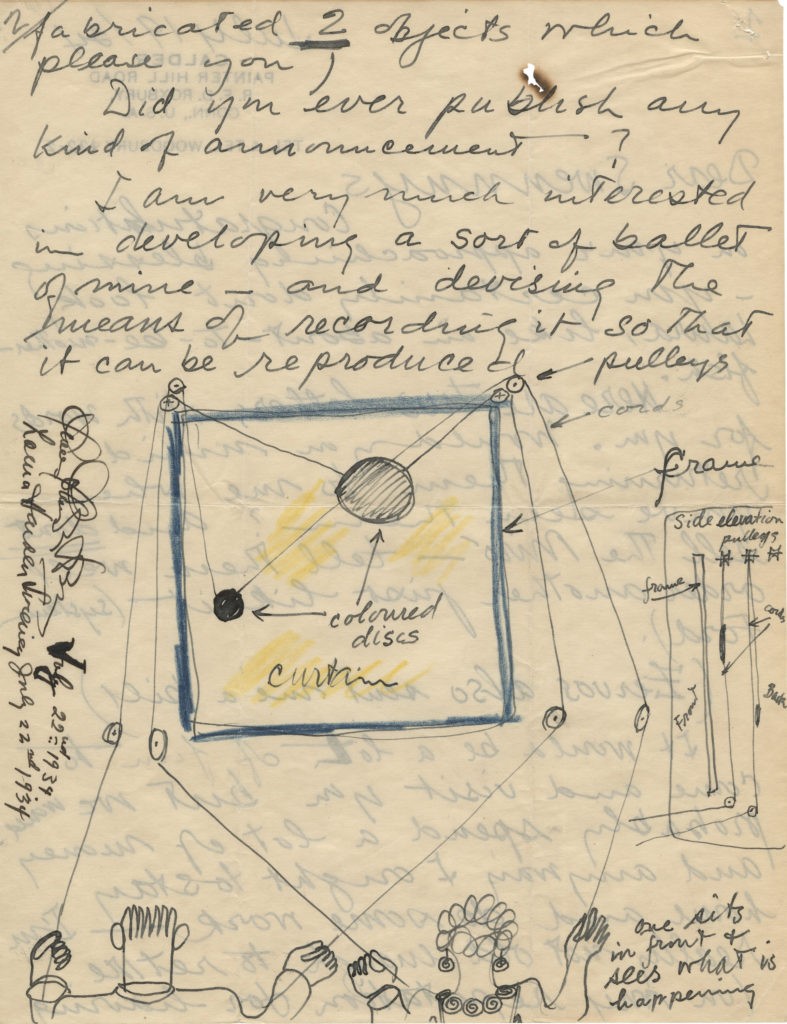
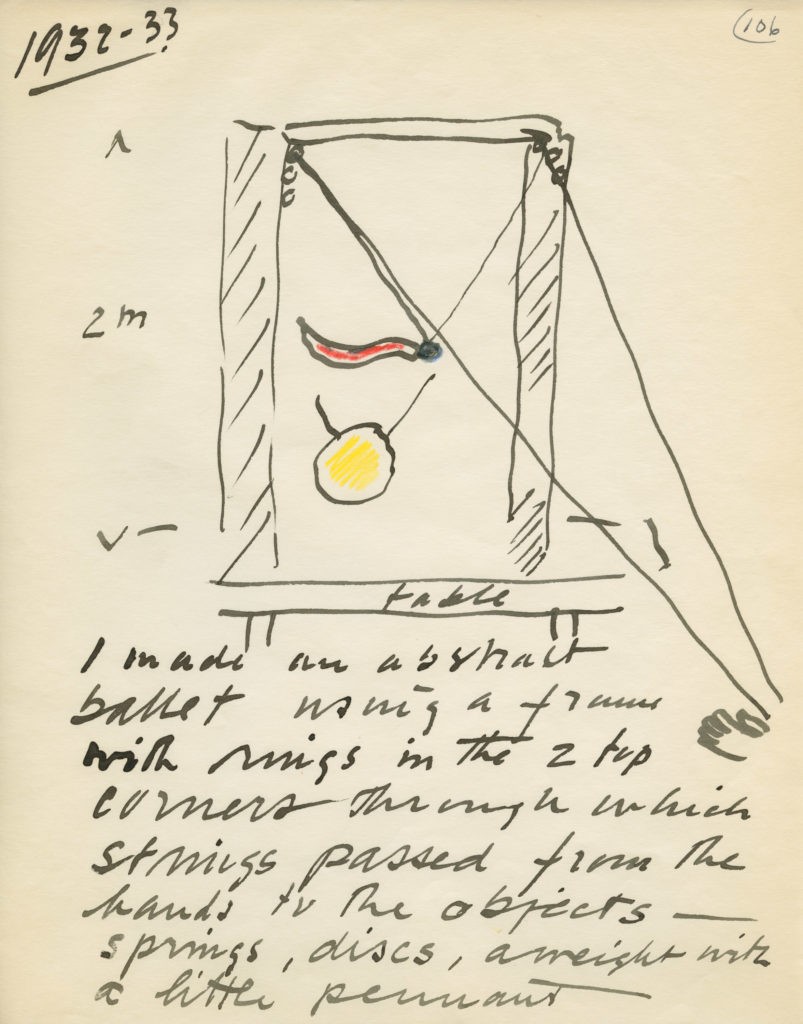
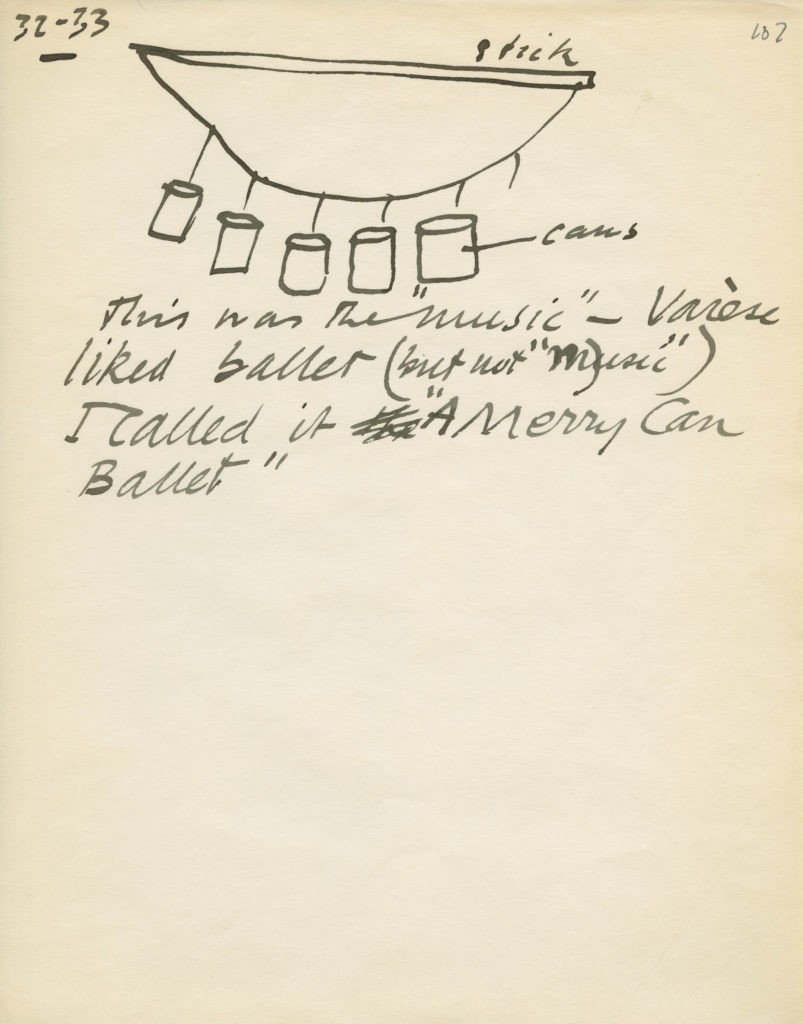
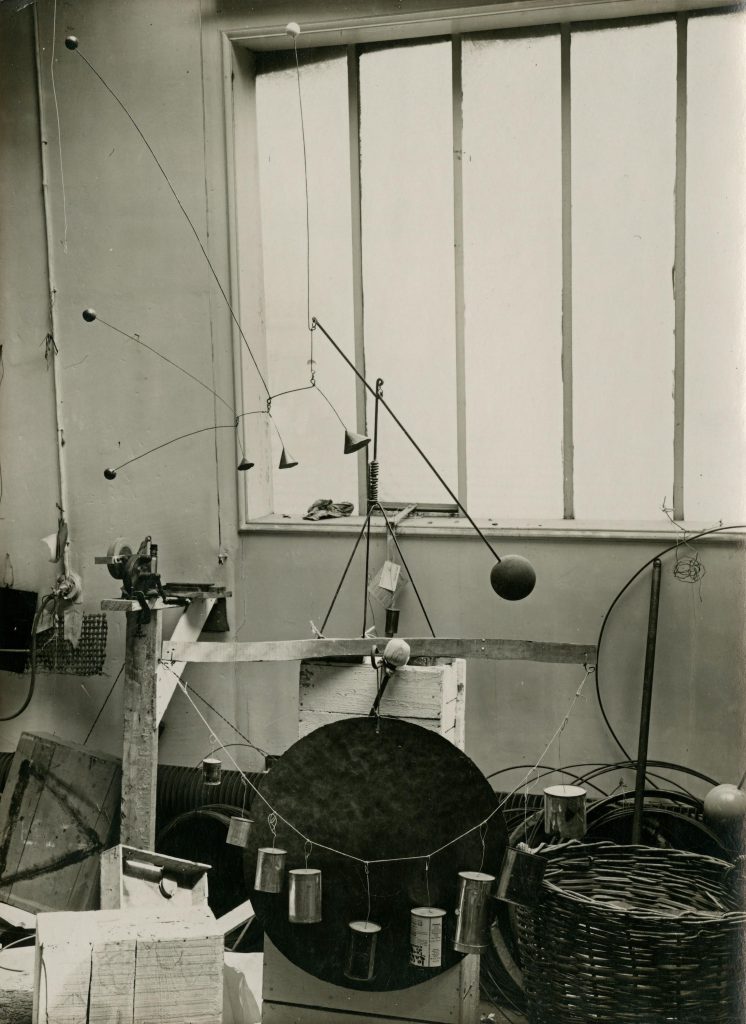
A ‘Mobile.’ Dimensions: 2 meters by 2.5 meters. Frame: 8cm, flat red. The two white balls turn very quickly. The black spiral turns slowly and looks as if it were always ascending. The steel sheet rotates even more slowly, the two black lines look as if they were always ascending. The black pendulum, 40 cm in diameter, rises 45° on each side, going outside the frame in front, at the rate of 25 swings a minute.
Calder used this statement, more like a specifications sheet than a traditional description of a work of art, to accompany the 1932 Cadre rouge (Red Frame), now lost, reproduced in the second journal published in Paris by Abstraction-Création in 1933.[1] The work can thus be reduced to this enumeration of objective facts, with the description of the movements taking on an importance at least equal to that of the objects, of their colors and dimensions. Calder felt that the innovation he offered was this importance accorded to motion, which opened an additional level to the abstraction of his time.[2] Motion, considered in and of itself, became a basic component of composition for Calder, along with surface, line, color: “Why not plastic forms in motion?” he asked during this period. “Not a simple translatory or rotary motion but several motions of different types, speeds and amplitudes composing to make a resultant whole. Just as one can compose colors, or forms, so one can compose motions.”[3] The composition of motion, whose use he justifies here, is a concept that must have been familiar to him, since he borrowed it from a conceptual universe that he knew well, that of the branch of physics known as mechanics. By the same token, the devices he invented to give it material form doubtlessly owe much to the scientific objects that demonstrate the major simple movements. The frames that Calder constructed at the beginning of the 1930s, such as the one already described, put into play Archimedes’ screws, pendulums that oscillate or have a rotary motion, and spheres that hang on the ends of extensible springs, like spring balances. John Perry’s Applied Mechanics, a book recommended (among others) to students by the Stevens Institute of Technology (SIT),[4] contains some plates demonstrating how these objects work, objects that Calder the engineering student may have had to handle.
Be that as it may, this reference to the external aspect of scientific objects would be merely anecdotal if it had not been apparent that Calder was also aware of one of their most essential qualities, springing from their pedagogic role: that of their demonstrative effectiveness. In order to achieve the most visible, intelligible demonstration, these objects incorporate devices with a frontal presentation (vertical brackets and frames, arranged high on bases or set on the horizontal plane of a table). Such devices, whose purpose is to catch the viewer’s eye, already carry the potential for performance. To function better, that is, to put a phenomenon on view so that observations may be drawn from it, these objects incidentally develop demonstrative properties—keep in mind that demonstration carries within it the Latin monstrare, to show, to put on view, to exhibit, to put on a show. These utilitarian objects thus become transformed into small theaters of objects in motion. It is certainly this aspect that Calder mainly drew on in those of his works inspired by these devices. Within this context, the specifications sheet that Calder used for the reproduction of Cadre rouge loses its apparent dryness and can be read as a sort of score detailing the role that these abstract objects play in a composition of motion, in a theater of movements.
If in art the strength of an idea can be ascertained by the variety of representations that it inspires, by the wealth of forms and signs that embody it as an extension of its field of application, then the composition of motion certainly qualifies as having that strength. Calder formulated the idea in the early 1930s and based his subsequent work on it. The composition of motion helped him to put into concrete form his vision of a painting in movement, born inside Piet Mondrian’s studio, where numerous cardboard rectangles were tacked up, forming a vast composition of pure colors. However, this notion also determined a series of theatrical strategies that profoundly marked a great number of works, especially in the 1930s, and served the artist’s intentions in his projects for the theater. The latter by no means represented a passing or incidental interest; on the contrary, both concerns shared a close and logical connection with certain principles of his art from the moment he discovered in it a strong propensity for motion, that is, for performance.
Calder had already made himself the director of his own work with his miniature Cirque Calder of the late 1920s. Its extrovert nature and its importance in commanding a public clearly affirmed the performance aspect of his work. This tendency was reinforced even more strongly by the invention of the mobiles; if motion indeed constituted the essence and the condition of the performance, then the mobile, which integrated motion’s causes and manifestations so well, is theatrical in itself and even, so to speak, despite itself. It represents nothing but presents performance in itself—the mobile, to borrow a term coined by Fernand Léger but, we would like to think, invented for Calder, is certainly the “performance-object” par excellence.[5]







Calder revealed his awareness of the potential for performance in his inventions by indicating precisely how his mobiles—particularly his mechanical mobiles—could be linked to the world of dance and choreographic technique. In a letter of 1934 to Albert E. Gallatin, he referred to his ideas for a collaboration with the choreographer Martha Graham based on a mechanical object that he had built some time before in Paris: “Martha Graham, the dancer, whose performance you may have seen last April in New York, and whom I consider very fine, was here last night—and we are going to try to do something together—my part being based on the idea of the ballet I worked by hand (with discs, bits of cloth, etc) when you came to the house in Paris.”[6] He described the same object in an autobiographical text of 1937, giving it the more explicit and significant name “ballet-object,” similar to the term performance-object invented by Léger: “For a couple of years in Paris I had a small ballet-object, built on a table with pulleys at the top of the frame. It was possible to move coloured discs across the rectangle, or fluttering pennants, or cones; to make them dance, or even have battles between them. Some of them had large, simple, majestic movements; others were small and agitated. I tried it also in the open air, swung between trees on ropes, and later Martha Graham and I projected a ballet on these lines.”[7]
This ballet-object is better known today thanks to a letter from Calder to James Johnson Sweeney in which he described it and drew it with a fair amount of accuracy so that someday he could establish the existence of his invention to this time and even, as he seems to have envisioned at one point, take out a patent on it. As far as can be determined from the drawing, this object consisted of a more or less square frame, white in color, set on a table. Inside it were abstract forms that could be moved by means of strings and pulleys: “The discs can move anywhere within the limits of the frame, at any speed. Each disc and its supporting pulleys is in a separate vertical plane paralleled to the frame. The number of discs can be increased indefinitely–depending on the necessary clearances. In addition to discs there are coloured pennants (of cloth), with weights on them, which fly at high speed—and various solid objects, bits of hose, springs, etc.” Calder also mentioned that “the backgrounds can be changed—and the lighting varied,” showing an early interest in the external possibilities of the presentation of his objects. He added a note to his drawing that specifies the use of his invention as performance: “one sits in front & sees what is happening.”[8] This frame, a small home theater, drew its inspiration from the kind around a theater where the stage is disclosed and attention is focused on the action unfolding on it. “Of course,” Calder notes, “the real problem [is] to magnify the movement to a full sized proscenium—but I can see various [ways] of obtaining it.”[9] This is exactly what the artist wrestled with many times during the course of his career.
In the same letter, Calder informed his correspondent that the object in question had existed since spring 1933 and that he had shown it to Léonide Massine. In fact, Calder’s correspondence from this period abounds in references to a project for the Ballets Russes, which ultimately came to naught.[10] On the other hand, this ballet-object was not limited to the frame described in the letter to Sweeney; it also included—as was only natural—an aural dimension: a series of tin cans suspended by a string to a wooden frame could no doubt be struck or knocked against one another to create sounds. This elementary device was sketched and dated 1932–1933 in an autobiographical manuscript by Calder, following another drawing of the ballet-object. But it was already known from a photograph of the Paris studio taken in 1932, in which a splendid mobile with spheres and cones set on a tripod can be seen on display. The theatrical nature of the mobile eclipsed the rudimentary garland of tin cans, whose use and true nature could not be understood without the directions Calder gave in his manuscript. The photograph shows the cans arranged by size, as if to set up a scale of tones, in front of a circular, metal plate (gonglike) crowned by a small, padded mallet, which was evidently used to strike the different metallic objects. About this time, Calder began to experiment with various ways of integrating sound into his mobiles. One of them, exhibited in May 1933 at the Galerie Pierre Colle, was described by the journalist Paul Recht, “We see two balls, one small and one large, respectively attached to very unequal lengths of string, themselves attached on their ends to the arm of a balance hanging from the ceiling. The large ball is animated by a rotary pendular movement, pulling on the small ball, which describes completely unpredictable spirals that increase through encounters with surrounding objects.”[11] In this description, we recognize the mobile Une boule noire, un boule blanche (One Black Ball, One White Ball) (c. 1932, reconstructed in 1969, Fondation Maeght, Saint-Paul-de-Vence), which was originally surrounded by more primitive objects found in the studio (such as simple wooden crates) rather than by the metal bowls of various sizes used today. In Untitled (The McCausland Mobile), 1937, a yellow torpedo, balanced by a red sphere, strikes a sheet of twisted steel suspended at the other end of a horizontal bar. This work prefigured a somewhat later mobile, Black Clouds, c. 1939, conceived to create collisions among spheres and sheets of metal. These works culminated in a series, Gongs (exhibited for the first time in 1952 at the Curt Valentin Gallery, New York), which was based on the same principle: a kind of haphazard composition of sound develops following the movements of the mobile, which swerves as individual elements collide.
This submission to chance and the use of exclusively percussive sounds were almost certainly consequences of Calder’s receptivity to avant-garde music and, more specifically, of his close friendship with Edgard Varèse, which had developed at the beginning of the 1930s. The musician visited Calder in his studio many times while he was preparing for his exhibition at the Galerie Percier. His wife Louisa wrote to her mother-in-law during this period, “Sandy is working downstairs, and talking to Varèse, the composer, whose music corresponds to Sandy’s wire abstractions, so he likes to watch him work.”[12] One of the spherical constructions exhibited soon after the show at Percier carries the title Musique de Varèse, a confirmation of the close association between the two men. Calder and Varèse shared a fascination for the scientific world, which can be seen in the titles of their works (Calder’s Volumes, Vectors, Densities; Varèse’s Hyperprism, Integrals and Density 21.5). Both were prone to similar cosmic musings; when Calder fabricated his Universe series in wire, Varèse was working on a draft of Espace, as well as a project that remained unfinished, L’astronome, in which Sirius collided with another star. But the relationship between Calder’s sound experiments, based on the production of percussive sound through a series of collisions, and Varèse’s compositions becomes interesting when we realize that the musician was at that very moment working on the score of Ionisation. Performed in March 1933 in New York, it was the very first piece for percussion alone composed by a Western musician. The humorous title that the sculptor gave his device, “A Merry Can Ballet,” may include another wink at the musician: “A Merry Can” sounds like “American,” or Amériques, one of Varèse’s best-known works, produced in Philadelphia in 1926. Under the drawing of his tin cans, Calder had the honesty to write that Varèse, although he liked the ballet-object, did not care for the music that accompanied it. Calder’s aural experiments, whether successful or not, indicate the artist’s wish to enlarge the theatrical possibilities of his devices by working out through them the bases of a total production.
The relationship that Calder established between his work (incorporating movement) and a form of expression like the ballet could have sanctioned a surprising conceptual analogy, even a certain unity of thought between the two. In each case, the idea of the composition of motion is the wellspring of the creation, inspiring and directing it at the same time. What other name could be given to choreography—an art of composing steps and forms, of ordering the changing configurations in the rhythmic succession of time—besides composition of motion? Calder himself laid claim to this identification when he explained the origins of the mobile: “I went to the use of motion for its contrapuntal value, as in good choreography.”[13] Previously, he had asserted the qualities of the motorized mobiles in these terms: “With a mechanical drive, you can control the thing like the choreography in a ballet and superimpose various movements: a great number, even by means of cams and other mechanical devices.”[14] The composition of motion would thus logically bring Calder beyond painting in movement to the theatrical setting of movement—that is, choreography. From a painting in movement, the mobile (or ballet-object, to use Calder’s term) became susceptible to applications on a real scale; it became a model that one day could be enlarged to the dimensions of an actual stage.
Moreover, this conceptual relationship reveals itself perfectly through Calder’s attempts at developing a notation to track the movement of forms and the successive positions that they occupied at each stage of a given temporal sequence. He returned to methods that went back to his technical training, in which the indications of sides and the measurements of angles, of the speed of movement, of the rotation and latitude of forms, were expressed with the help of symbols derived from engineering drawings. But these methods competed with another type of schematization, which arose from a source different from technical drawing. This can be seen, for example, in one of the studies for Ballet in Four Parts, as well as in the print Score for Ballet 0–100 of 1942. Calder drew sinuous lines interrupted at intervals by short straight lines accompanied by numbers corresponding to divisions of an arbitrarily chosen temporal duration, in the two cases ranging from 0 to 100. In the drawing, the principal form (a sort of inflated large triangle) enters into action at 17 on the right, makes three turns on itself toward the center, then descends and disappears toward the bottom, setting on the stage at 45. The larger of the two disks appears at 3 ½ in the upper left corner and, as it descends, describes large loops, which grow tighter as it moves up again, before vanishing from the frame at 15. The spacing of the temporal subdivisions, tighter in the disk’s trajectory, indicates that it must be subject to a faster movement than is the principal form, although not as fast at that of the pennant that crosses the frame between 0 and 3.
Through this process, Calder reinvented the oldest type of notation ever codified to retain the trace of creations ephemeral by definition—ballets and dances. Choreography, in its etymological sense as the written transcription of movements, was invented by Raoul-Auger Feuillet, author of the first treatise on the subject, Chorégraphie, ou l’art de décrire la danse par caractères, figures et signes démonstratifs (1700). Placing himself perpendicular to the plane of the stage, he schematically transcribed the evolution of the dancers’ positions using a continuous line regularly interrupted by short line segments. The many plates in the treatise reveal the degree to which Calder became heir to Feuillet, whose method was not seriously challenged until Rudolf von Laban introduced choreutics at the beginning of the twentieth century.[15] It is impossible to determine if Calder rediscovered this choreography on his own or if its use had been suggested to him through his contacts with dance professionals such as Martha Graham. In any case, we find here confirmation that the idea of the composition of motion developed by Calder led him to think of movement and to notate it in a way that offers a close parallel with dance and that, more than anything else, points to the mobile as an intrinsically theatrical object. The composition of motion thus finds its culmination in the theatrical setting of movement.
Calder’s output of the 1930s is not without works endowed with theatrical devices analogous to that offered by the ballet-object described in the letter to Sweeney. They can be considered as so many prospective examples of the artist’s ideas about the adaptation of his forms to theatrical space. The frames appeared in 1932 with the first mechanical mobiles exhibited at the Vignon gallery. Created two years later in New York, White Frame (1934, Moderna Museet, Stockholm) and Black Frame proposed an analogous composition of motion, in a space almost two-dimensional in the first case and closer to the stage box in the second. The gray sheets of metal facing different directions compose a background against which the forms in movement stand out: a white spiral, a red sphere, and a flat disk that in turn displays a white and a yellow side. In the absence of such a background, Calder placed his frames against the walls, set slightly forward, or tipped, as seen in an old photograph of Vertical White Frame. This photograph also reveals the important role that the play of projected shadows against the walls assumes in the perception of such works.
A group of mobiles in which a hoop of wire plays the same role of spatial limitation can be linked to these mobile-frames. An early example is the Untitled (Mobile) created circa 1931. It was followed several years later by numerous works of this type, such as The Circle. This mobile, which once belonged to the art historian Agnes Rindge Claflin, is based on a composition of pendulums and is hung from the interior of a circle. Like the frames, this device provides the mobile, which is usually without center or limit, with an enclosed and limited space. Mobiles that are freely suspended join what Calder called “the large space,” that is, the cosmos. The frame or hoop imposes a force inverse to the centrifugal force of the mobile, as it forces the viewer to concentrate on the configurations that occur in the heart of a materially delimited portion of space. Calder’s instructions for the presentation of such works provide confirmation. In January 1935, he wrote to Chick Austin, who was preparing an exhibition at the Renaissance Society in Chicago, “The circle should be a perfect circle and should stand up very straight—so if anyone bits [sic] on it in transit you might bend it back. The little straight wires should be approximately horizontal. The center of the circle should be at eye level. A simple wall space as a background is of course the very best.”[16] Frames or hoops should thus focus the spectator’s attention and encourage him or her to view the mobiles from the front, as both conditions are required for the contemplation of the performance offered by forms in motion.
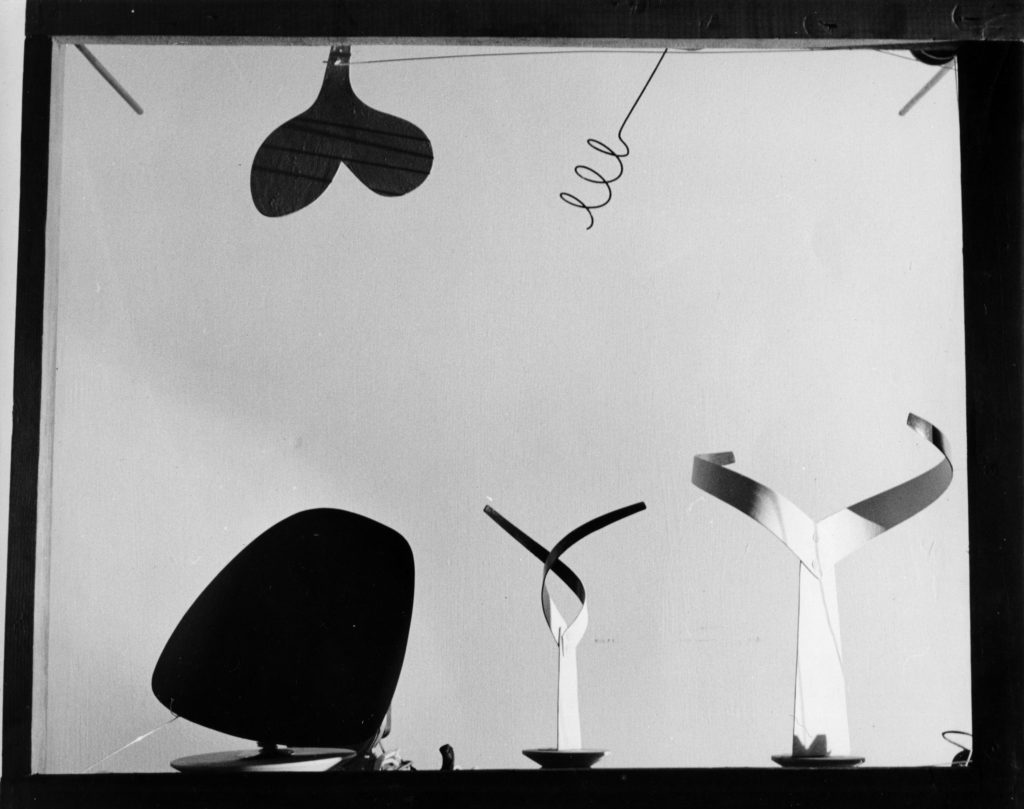
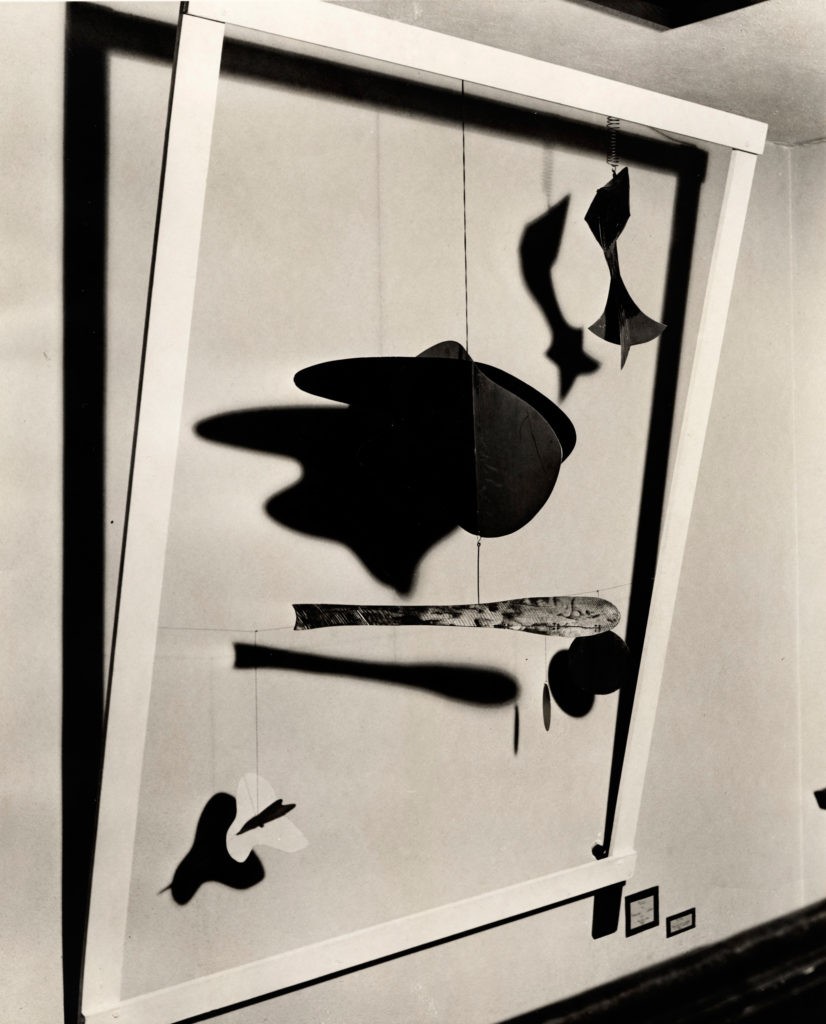
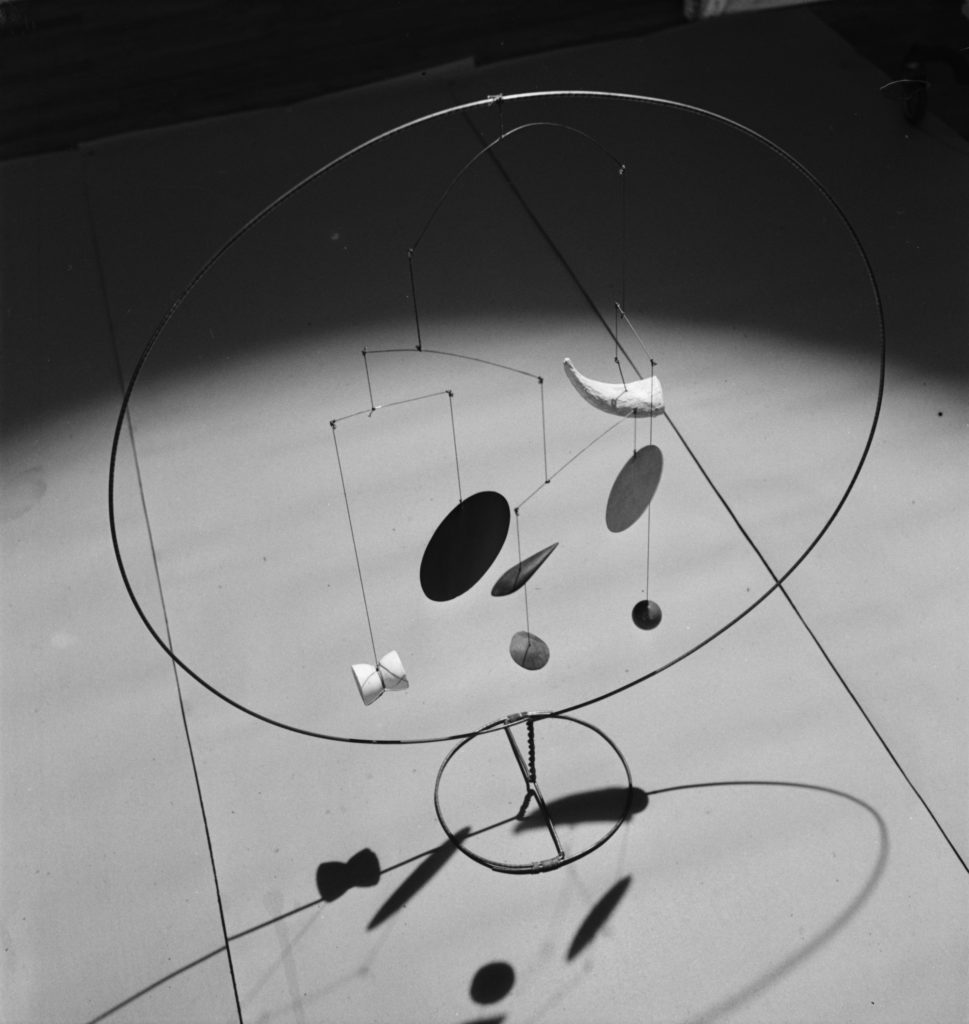
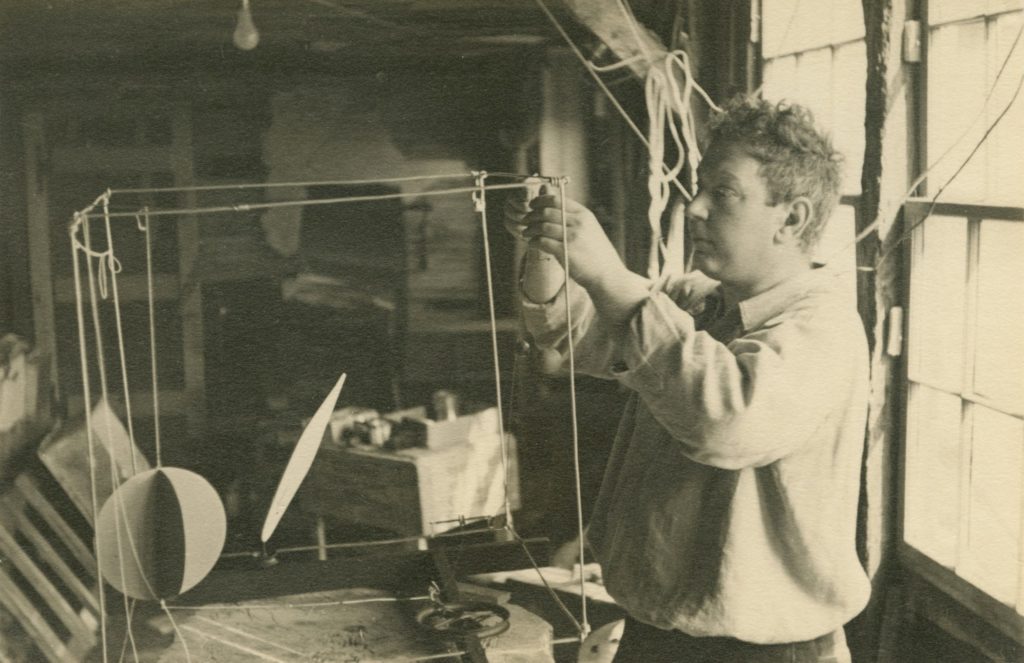
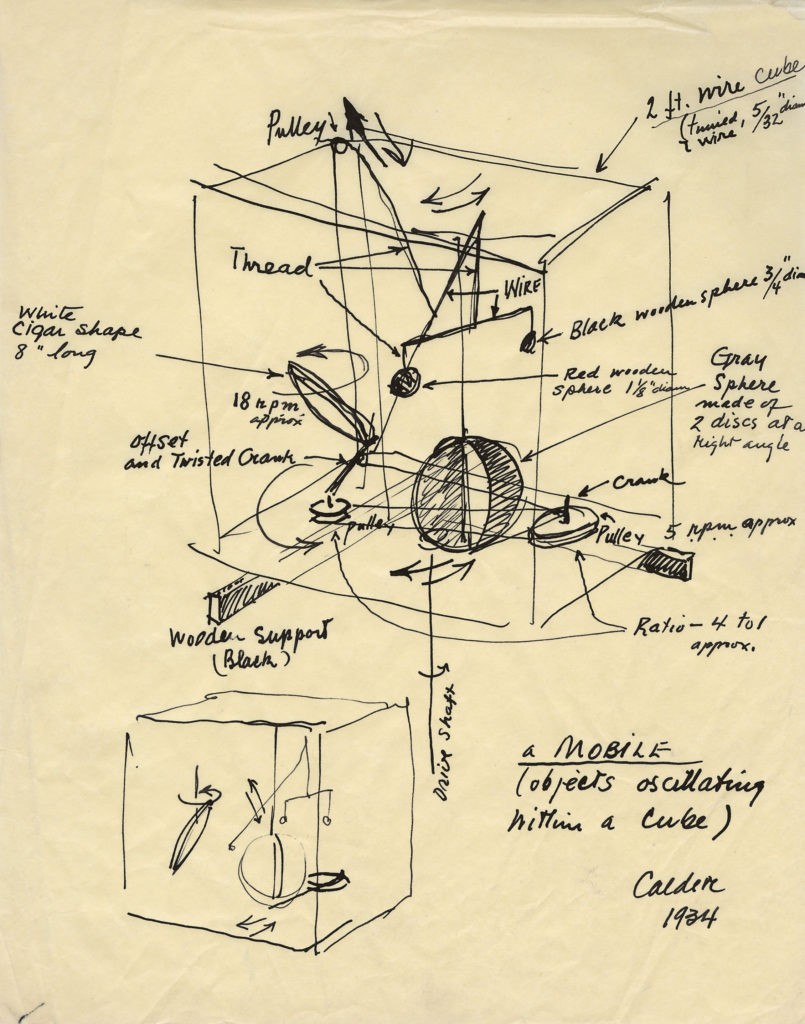
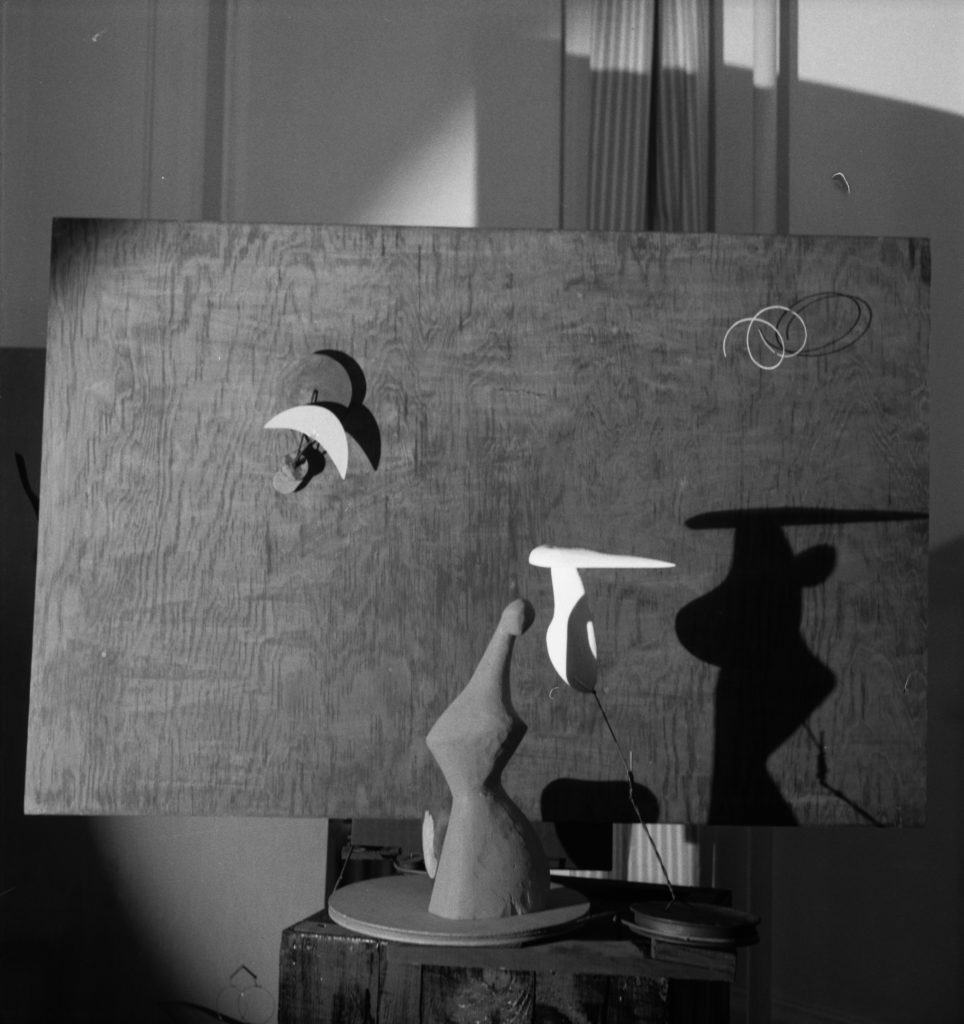
In 1934 Calder, while apparently working on an important theatrical project with the American composer Harrison Kerr, fabricated one of his most remarkable ballet-objects; only a photograph and designs detailing its composition and function remain. The artist constructed a transparent cube, each side about 60 centimeters long, from lengths of wire, defining a space for the action. In the center is set a white spindle-shaped form, a large gray sphere created by the intersection of two disks at right angles, and a mobile composed of two wooden spheres, one black and the other white. A mechanism of pulleys and strings links all these objects together and makes their movements interdependent. It is not known if this device was to constitute a simple movable decor or if these objects were invested with the role of independent actors—a crucial question, as we shall see, presented by Calder’s projects for the stage. In his article “Le ballet-spectacle, l’objet-spectacle,” Fernand Léger had already criticized the prominent role accorded the actor on the stage and protested against the idea that a performance should be constructed around a single pole of attraction. “It should be possible to go beyond this theatrical order,” he said, “to arrive at a different scheme in which the star returns to the plastic level, where a mechanical choreography closely tied to its decor and music achieves the desired unified whole; where the decor, previously stationary, becomes mobile, where the interest of the performance is carried throughout the entire stage.”[17] In another text, Léger went further and envisioned completely dispensing with the human presence on the stage. In this new theatrical art, the reduction of the role usually accorded people corresponded to an expanded role played by the object, the plastic object in motion: “Let us gradually take away the ‘little man,’ and I assure you the stage will not be empty, for we will make the objects move.”[18]
“Make the objects move”: this was clearly Calder’s goal for his ballet-objects, which he made repeatedly in the 1930s after his initial experiments. Many of them were built on a model deriving from the project for Harrison Kerr: a horizontal platform (a stage) supports colored forms (the actors, dancers) with ropes and pulleys that allow them to spin. In Danseurs et sphère (Dancers and Sphere) (1936, private collection), the “dancers” of the title are “ribbons” that rise up and twist their bifid ends, or “arms,” indicating the direction in which the movement will lead them. They are associated with forms often encountered in the category of the mechanical mobiles: the sphere and the spindle, as in the ballet-object for Harrison Kerr. One of these dancers appears in a slightly later maquette, 1939 New York World’s Fair (1938, Moderna Museet, Stockholm); but in another 1938 maquette, 1939 New York World’s Fair, it is replaced with a spiral band, a form whose mechanical perfection is accented by the brilliant surface of the unpainted polished metal.[19] Calder later returned to a similar arrangement for the Philadelphia Museum of Art’s Untitled (Construction) of 1955, which may have something in common with a project for a stage set. All these works give the impression of a stage floor on which actors and dancers have been replaced by brightly colored, abstract forms, endowed with life that gives them movement from which they produce the material of true performances in miniature.
Many other mechanical works also serve to demonstrate their conceiver’s penchant for devices geared toward theatrical presentation. Relief mobiles, for instance, feature a vertical panel, against or in front of which the forms move. The forms are generally arranged on a horizontal platform or on the top of a case, which also conceals the mechanism—a device that repeats the analogy with the stage floor, with the addition of a back panel. Little Blue Panel (1934, Wadsworth Athenaeum, Hartford, Conn.) is an early example of these performance-objects. Like them, it is so laden with theatrical characteristics that it is not at all difficult to imagine it transposed to a larger scale, in which the abstract forms—here two spheres and a spindle—would themselves create the performance. However, the presence of the back panel, which so strongly creates the impression of a miniature theater, is entirely fortuitous in this case. Calder added it, at the request of Pierre Matisse, to mask the pulleys, as he explained in a letter to Ben Nicholson. He painted it pale blue so it would blend with the color of the curtain, which it would be exposed against.[20] In his first version, the object was not necessarily devoid of traits that evoke the world of the stage. Besides, the studies prepared circa 1934 for Ballet in Four Parts include four animated devices; one, with two spindles facing one another, connected to a disk or a smaller sphere, is very similar in composition to Little Blue Panel. Therefore a connection might exist between that project and the mobile in Hartford. Another Little Blue Panel (c. 1936, Musée National d’Art Moderne, Centre Georges Pompidou, Paris) presents comparable theatrical characters: the “proscenium” supports, on a slightly raised step, an object composed of two pieces of sheet metal placed together. It spins to show, in turn, surfaces painted red and black; its movement is adjusted to that of a small, bright, yellow disk that describes segments of a circle against the blue surface of the back panel. This detail gives the work a certain resemblance to the stage decor that Miró created for Léonide Massine’s ballet Jeux d’enfants (1932), in which the same form, carried to the top of a white swath, rose and fell in the background. The most theatrical of the reliefs in this series is, without doubt, Blue Panel, whose vertical background bears small, animated objects (crescent, disk, spiral). These serve as simple ornaments, so to speak, to the large, abstract shape (set on a pulley in front of the panel) that is a kind of slender-waisted dancer accompanied by a form held in the air by a twisted wire. This work and many others already mentioned were exhibited together in one room of the Museum of Modern Art’s 1943 Calder retrospective. This grouping made clear the relationship that linked many of these devices. Ranged against the wall in the space where paintings usually go, they were presented both as paintings in movement and as spectacles staged in small theaters, in which the movement of forms is the object of the productions and serves as the subject of the performances.
Numerous documents (old photographs, descriptions of installations) also bring home the importance that exhibition conditions held for Calder, especially the lighting of his works. His unusual use of the shadows that they cast contributed significantly to the formation of a painting in movement as well as to the theatrical presentation of the work. For instance, Calder suspended some mobiles from a small bracket attached to a flat back mounted on the wall. These wall mobiles are similar to the mobile-frames; the flat background (panel) serves as a “frame” for the mobile. The wall panel, as beautifully illustrated in certain photographs by Herbert Matter, becomes the support for a web of shadows that closely links the suspended, seemingly floating, objects to the surface behind them. Through lighting, Calder projected the images of the three-dimensional objects beyond themselves and caused an anamorphic illusion of moving silhouettes, flat and deformed. His Swizzle Sticks, 1936, is one example; a web of interwoven straight lines is projected on a vermilion-colored field. The panel of another wall mobile is already a kind of painting, bearing a geometric composition formed by two squares, a rectangle, and a circle. Suspended form the crosspiece crowning the panel, the mobile balances a white sphere and a wire tracing spirals in space. A photograph by Herbert Matter shows how these two elements become integrated in the existing composition: the shadows cast by the forms and lines are superimposed on the panel; the moving mobile constantly creates new motifs.
In an important article dedicated to “relations of painting and sculpture” and their “paradoxical metamorphoses,” painter and art critic George L.K. Morris noted the theatrical aspect of the lighting selected by the artist: “I have further observed that shadows cast on a wall by Calder’s mobiles are apt to be more dramatic than the works themselves, and like paintings, tend to discard a sense of actual scale; when in motion even the newer province of the cinema seems invaded here.”[21] Calder himself installed his 1937 and 1938 exhibitions at the Mayor Gallery in London. “Some of the objects were very slender and filmy—little lines of fine wire—and I used to turn out the light and project them on the wall with a flashlight as they turned around.”[22] He kept two photographs that show him arranging his works for one of these exhibitions; the dark space is lighted only at intervals to make the works loom up in a luminous halo. A journalist reported, “Against white backgrounds and under direct illumination these jiggling contraptions with their delicate lines and balls and discs of red and black would draw delightful patterns of shadow.”[23] Many of the London critics, including Anthony Blunt, compared the presentation of Calder’s works with a new kind of choreographic art: “The rhythmic swing of the flexible wires and the dancing of the balls are as complicated and as finely executed as the steps in any ballet.”[24] Later, in 1948, Calder’s mobiles were the subject of one of the seven sequences in Hans Richter’s film Dreams That Money Can Buy. A mobile is shown suspended in a dim, dark space. As light is projected on it, the mobile moves, throwing shadows, flashes of light, and reflections on the wall of the room. This sequence, entitled “Ballet,”[25] shows how the mobile, exhibited in certain conditions, transforms itself into a “modulator of space and light,” to borrow László Moholy-Nagy’s description for his own constructions. Like them, Calder’s mobile generates a theater of immaterial and moving shadows.
Calder’s first opportunity to participate in the creation of a ballet that included his own works came from Martha Graham. They created two dances: Panorama (Bennington Festival, Vermont, 14 and 15 August 1935) and Horizons (Guild Theater, New York, 23 February 1936). While their collaboration is often described in idyllic terms, it was not without problems. Panorama was considered only a partial success, but its faults made it more interesting than its strengths. Most of the critics remarked on the ballet’s experimental aspect, which was well within the spirit of the Bennington Festival. The culmination of six weeks of work, Panorama was written for thirty-six dancers; only twelve of them belonged to Martha Graham’s company. In the short rehearsal period, it was necessary not only to train young dancers with little experience but also to coordinate all the other elements of the production, under the direction of individuals who had never before attempted a collaboration of this sort.[26] The program written for the performance offered the following chronology: “The choreography for ‘Panorama’ was begun by Martha Graham on July 15. The technical work by Jane Ogborn, the composing of the mobiles by Alexander Calder were begun the following week. The designing and execution of the setting and lighting by Arch Lauterer have been carried out in the final half of the session.”[27] Martha Graham named this temporary company, which formed for the brief span of one performance, the Workshop Group. It captures the inquisitive, experimental spirit that was required to guarantee a production firmly avant-garde in all of its elements. Today we have a sense of Calder’s role in this process from the observations of some of the other participants. Ruth Lloyd, the wife of the composer, remembered, “Calder had devised two mobiles for the dance. The first was a set of primary-colored discs, suspended from pulleys. Each disc was attached to a wrist of one of the five dancers. The effect was stunning, with the dipping and rising space patterns of the discs counterpointing the slow-moving, earth-bound movement of the dancers. But Calder’s second mobile never worked. He had designed a huge wooden machine, jointed so that it could leap across the whole stage like a jagged bolt of lightning. Something went wrong, either in the design or in the execution of the design. The joints of the machine responded arthritically at best. This mobile never made it to the Armory.”[28] While the mechanical mobile seems unfamiliar, the free mobile described here might be the one shown in a 1943 photograph of the garden at the Museum of Modern Art and sketched in a letter to Agnes Rindge Claflin, in which Calder called it a large overhead mobile that was designed for use by Martha Graham.[29] The Panorama mobile was made from a succession of four disks and a small red ball, held on the ends of long horizontal rods. It was designed not to function as a simple decorative prop but rather to participate fully in the choreography. As made clear by Ruth Lloyd’s observations, it worked not by juxtaposing its movement with that of the dancers but by making them blend organically, physically linked together, in the same circle of reactions produced by the same causes. Because it was difficult to handle, this mobile had to be abandoned and hastily replaced with a much simpler device, according to accounts of the time: “The introduction of mobiles was a distinctly new departure. These mobiles were designed by Alexander Calder, whose ideas, for lack of space and time, could not be fully carried out. In the two memorable performances, other forms had been discarded in favor of two large colored cardboard discs, moving in counter-motion with the dancers.” However, the journalist concluded, “their possibilities are beguiling.” This conclusion is justified if we measure these possibilities against the boldness of the artist’s earlier intentions.[30] Having absorbed the lessons of this attempt, Calder and Graham took a different approach with their second collaboration.
For Horizons, Calder no longer sought the unattainable fusion of his forms and constructions with the choreography proper; instead, they performed separately beside it, in alternation with it. The ballet had four movements. Between each one, Calder controlled the stage, producing what the program called “visual preludes.” These were completely independent of the choreography; the two elements of the ballet—dance and mobiles—retained their autonomy as well as their own spatial and temporal domain. As Martha Graham wrote in her memoirs: “It was new in dance, and we wanted to draw the attention of the public to the opposition between the role of the dancers and that of Calder’s pieces.”[31] This idea led them to insert a note in the program that clearly explained, “The ‘Mobiles’ designed by Alexander Calder, are a new conscious use of space. They are employed in Horizons as visual preludes to the dances in this suite. The dances do not interpret the ‘Mobiles’, nor do the ‘Mobiles’ interpret the dances. They are employed to enlarge the sense of horizon.”[32]
The extent of Calder’s role in his second theatrical production, as in his first, Panorama, can be reconstituted only through documents. However, a few drawings for Ballet in Four Parts might give an idea: “ballet in four parts” is the name sometimes given to Horizons, and these drawings present arrangements of forms that recall written descriptions found in the press at the time of the ballet. Henry Gilford, in Dance Observer, expatiated on the plastic qualities of the mobiles, which gave the impression of paintings in movement: “’Mobiles’, as used by Martha Graham in her presentation of Horizons, are groups of abstract designs, geometric still-life patterns in motion; spheres, cubes, hexagons, spirals, straight lines, utterly shapeless figures and the combinations of them, variously colored, moving (by mechanical means) in a fixed design. It were as if Paul Klee had projected itself out of its canvas and put itself under the Guild [Theater] floodlights.”[33]
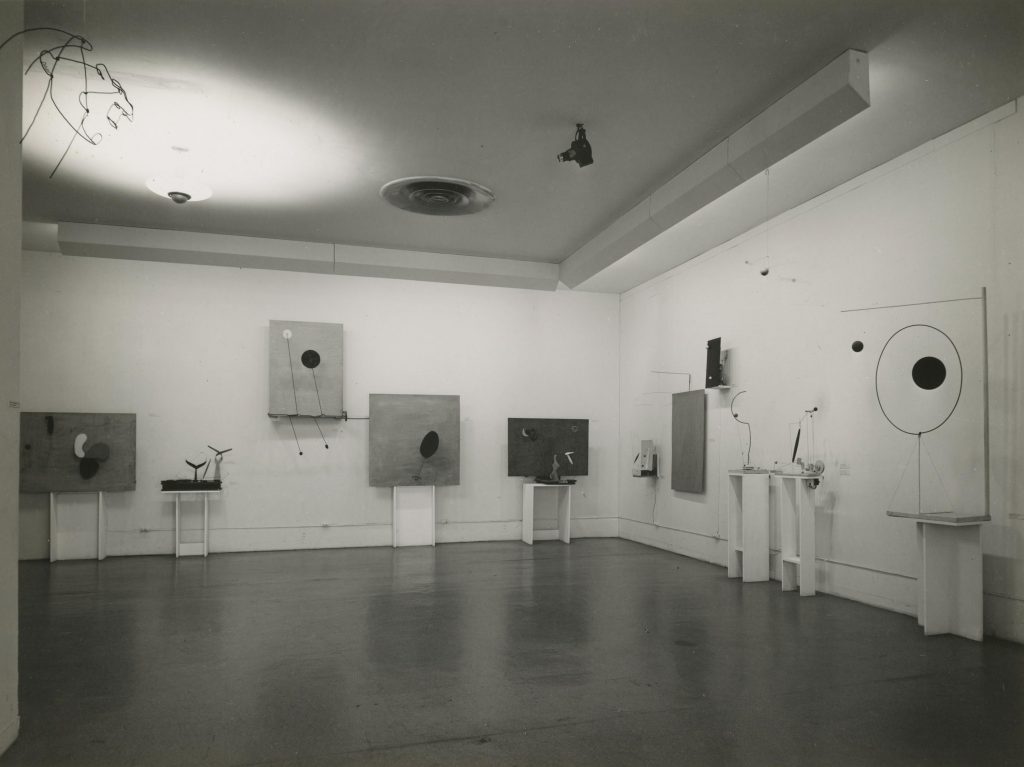
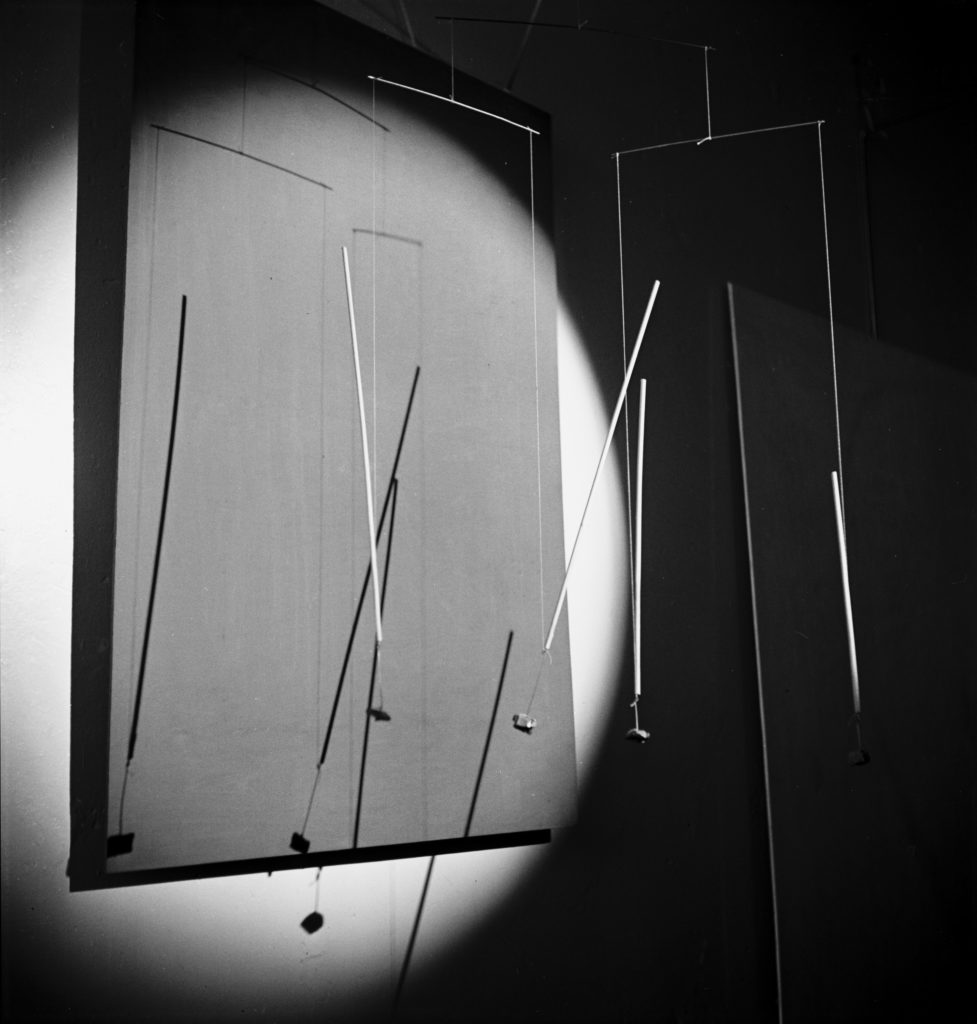
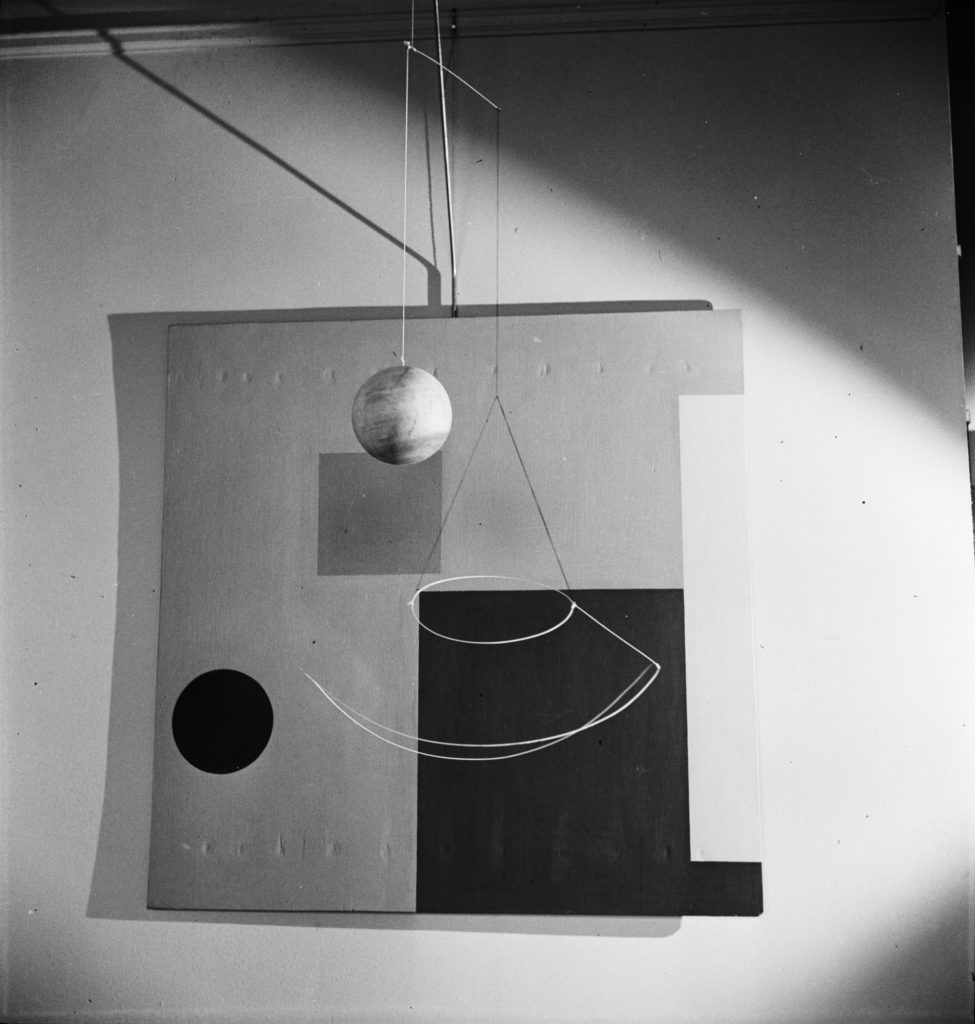
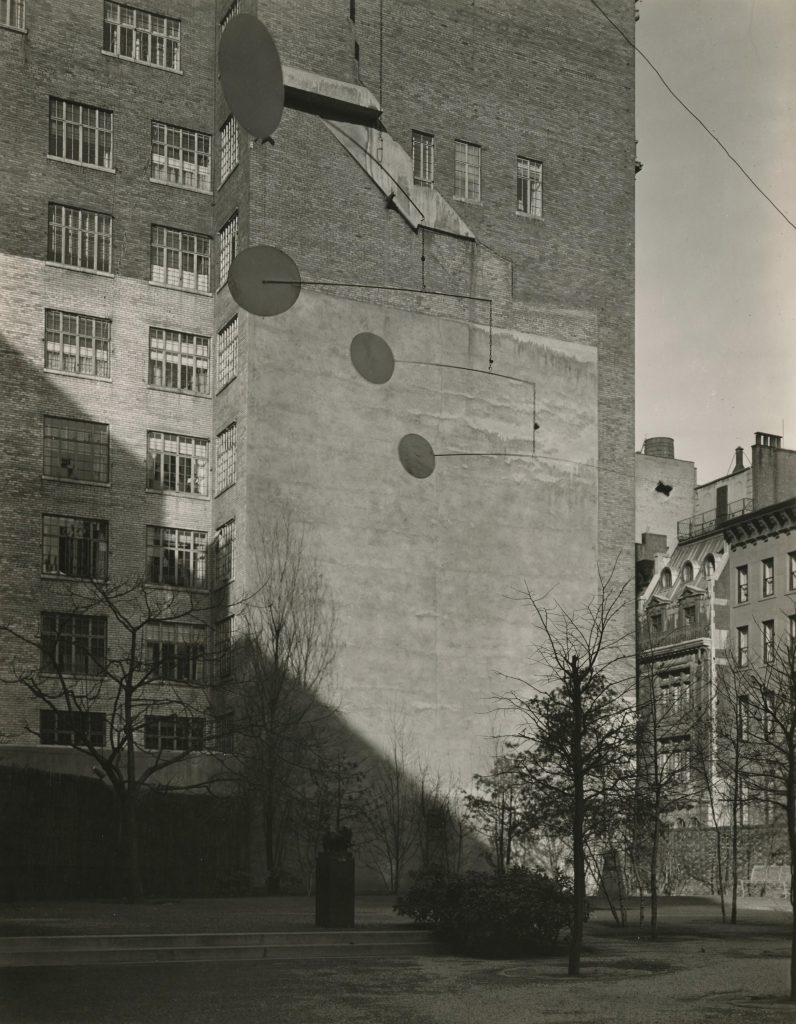
While Gilford did not challenge their plastic qualities, he nevertheless posed the pertinent question of the use of mobiles in the context of dance—a problem for dance critics in general: “Perhaps, mobiles will find a way into the concert dance and, as the various stationary props, become more and more a part of dance composition; we have no real reason to suppose anything to the contrary, and rather than completely condemn the use of Calder’s inventions in Horizons, it were better, perhaps, we realize the particular inadequacy of the particular creations, the inaptness of them, and stop there.”[34] John Martin, the dance historian, took the same approach as Gilford in acknowledging the formal qualities of the mobiles but relegating them, in the last analysis, to the rank of simple prop, asserting that “to adapt them in some way to make them serve the dance has been Miss Graham’s concern.”[35] In effect, all the critics had difficulty in visualizing the mobiles as anything other than a secondary attribute—and a troublesome one at that—of the dance. For someone like Gilford, the mere presence of these cumbersome props could place the very existence of the choreography in jeopardy: “Mobiles may be pleasant to watch … perhaps we will have mobile concerts. But for Martha Graham, such mechanical aids as used at these two concerts serve only to create a diffusion, have nothing to do with the dance choreography and act as distracting forces that tend to break into the unity of the composition.”[36]
Thus, despite their separation, the two elements of the performance flowed into one another and were mutually constrained in the perception of the viewer. Yet, in finding Calder’s mobiles inadequate, the critics pointed to the true problem with this type of performance: the rivalry between the choreography proper and moving sculpture could not be reconciled within the same production. Henry Gilford’s observation, which is basically justifiable, goes to the heart of the ambiguity created by the Graham-Calder collaboration: “Somehow mobiles and Martha Graham do not speak the same language.”[37] Perhaps, after all, they could not.
Calder experienced the same difficulties, for the same reasons, with another choreographer, Ruth Page. At the end of 1935, Calder was contacted by Page’s agent, Thomas H. Fisher: “Ruth and I have the idea that you should construct for her a large scale ‘mobile’ to be used alone on the stage, with music and lights between her ballets. The idea would be to enlarge such a mobile as the one I saw in the Museum of Modern Art to stage proportions using different colored objects in motion and then playing lights on the mobile from the wings and elsewhere in the theatre. The music would, perhaps, be something like Varèse or something else which would be suitable to the particular mobile being displayed.”[38] Calder sent a large mobile to Page, who made an effort to familiarize herself with its handling. The early reactions of the choreographer are revealing: “I have been experimenting with my mobile which you sent here and have decided that it is much more beautiful without me than with me. Any movements of mine just spoil it. However we tried it just in the room here with lights and music and it is a thrilling dance all by itself and we would have to produce it just by itself with lights and music. Blow an electric fan on it so that it moves very slightly. But it seems to me there should be a little group of 2 or 3 to make an impression—like 3 short dances.”[39]
Although fascinated with Calder’s mobiles, Page did not include them in her productions; instead, she became convinced of their autonomy. Ten years later, however, Calder received another invitation to collaborate with her on a ballet, entitled Billy Sunday, whose libretto was inspired by four sermons on temptation given by an American evangelist.[40] Calder was to provide the props, a curtain, a stage set, and, most important, mobiles. While the traditional props never presented any problems, the presence of the mobiles created discord between the artist and the producers. After numerous attempts at reconciliation, Fisher finally confessed their reservations to Calder: “I am very doubtful about the hanging mobiles because I do not see how these can fit into the movement of the dancers. The moment that the scenery moves at all, it invariably draws the attention of every eye in the audience. In the new ballet ‘Undertow’ which Ruth and I saw in the Met. Opera House last Saturday night, the scenery at the end moves upward … The movement is very slow, but I think it is plain that the entire audience watches the scenery move up and completely forgets to look at the dancers while the scenery is in motion. The effect in this case does not disturb the whole work because the motion only takes place over about two min’ time and the change in the scenery is very effective. If the hanging mobiles are used, however, they will necessarily be in motion during the entire performance; and I think it is perfectly certain that this motion will ‘pull the ballet apart’ scenically.”[41]
Calder’s mobiles had rivaled the choreography yet again; as in the ballets with Martha Graham, the scenery in movement impinged on the movement of the dancers or even took their place. The motion of the mobiles created its own dance that overshadowed that of the ballet proper and risked displacing it. Yet the reservations of various dance professionals clearly demonstrated, conversely, the true theatrical possibilities of the mobiles, the performance-objects. The criticism that they regrettably distracted from the choreography amounted to an affirmation of their theatrical effectiveness, of their ability to present a performance by themselves.
After Horizons, Calder allowed his true ambition for theatrical productions to emerge: he wanted to dispense with any action onstage other than that of his animated forms, which would then no longer merely serve as decorative sets or props. Rather, he wanted the presence of his work to replace every other presence, especially live actors and dancers. Calder thus endorsed a course that the avant-garde theater had been pursuing since the 1910s: the actor was depersonalized, mechanized, and, ultimately, replaced by a theatrical mechanism, a “performance-machine.” From the biomechanics of Vsevolod Meyerhold to Oskar Schlemmer and the Bauhaus theater group, this objective—mechanized performance, choreography without dancers, and theater without actors—was explored by many artists, stage designers, and producers, including some close to Calder, such as Fernand Léger and Frederick Kiesler. They saw in the art of the stage the possibility of producing a world invented and completely controlled by the artist, a world that owed everything to his conception alone. Calder was speaking of no other ambition when he declared in 1937, in reference to his ballet-object of the Parisian period, “My idea with the mechanical ballet was to do it independently of dancers, or without them altogether.”[42]
Calder had only two actual opportunities to realize this idea: Socrate, performed in February 1936, when he was just beginning to work on theatrical projects, and Work in Progress, staged in 1968, at the end of his life.
Directed by Virgil Thomson, Socrate was performed in the auditorium of the Wadsworth Athenaeum in Hartford, Connecticut. Calder’s mobiles alone accompanied the symphonic drama that Erik Satie had composed in 1920. Such a production, in which performance-machines replaced the human presence, had been questioned by Oskar Schlemmer: “How long can a spectator’s interest be held by rotating, swinging, humming machinery, even if accompanied by innumerable variations in color, form and light? Is entirely mechanized drama to be thought of as an independent genre, can it dispense with man except as a perfect mechanic and inventor?”[43] Calder’s Socrate answered the second question in the affirmative; he evaded the danger pointed out in the first question by dividing the relatively short piece into three dialogues—nine minutes for each of the first two parts, eighteen minutes for the last.
Calder described and diagramed his stage design in a written report begun the following year. This neutral, concise statement details the technical and formal characteristics of his device: the dimensions, colors, duration, direction, and extent of its movements. The report, through dry, is clear and objective, with nothing to detract from the bare recital of facts.[44] “There is no dancing in it,” he warned at the outset, and we can gauge the importance of such a detail in light of the ambitions that he had nursed for his theatrical mobiles. He continued, “The proscenium opening was 12 feet by 30 feet. There were three elements in the setting. As seen from the audience, there was a red disc about 30 inches across, left centre. Near the left hedge there was a vertical rectangle, 3 feet by 10 feet, standing on the floor. Towards the right, there were two 7 foot steel hoops at right angles on a horizontal spindle, with a hook [on] one end and a pulley [on] the other, so that it could be rotated in either direction, and raised and lowered.” The description does not end with the objective and verifiable elements of the composition of the forms; it would be incomplete, of course, without a description of the composition of motion: “During the first part the red disc moved continuously to the extreme right, then to the extreme left (on cords) and then returned to its original position, the whole operation taking 9 minutes. In the second section there was a minute at the beginning with no movement at all, then the steel hoops started to rotate toward the audience, and after about three more minutes they were lowered towards the floor. Then they stopped, and started to rotate again in the opposite direction. Then in the original direction. Then they move upwards again. That completed the second section. In the third, the vertical white rectangle tilted gently over the right until it rested on the ground, on its long edge. Then there was a pause. Then it fell over slowly away from the audience, face on the floor. Then it came up again with the other face towards the audience; and that face was black. Then it rose into a vertical position again, still black, and moved away towards the right. Then, just at the end, the red disc moved off to the left. The whole thing was very gentle, and subservient to the music and the words.”[45]
This description, a veritable score of movements, gives an idea of the extreme simplicity of the set for Socrate: only three geometric forms, three colors—the black, white, and red trinity of Calder’s earliest abstract compositions from the beginning of the 1930s. In this minimal composition of motion, the forms moved one after the other, never simultaneously. The restraint and spareness was meant to harmonize with the subject: the sacrifice of Socrates. According to Virgil Thomson, Calder’s stage set communicated perfectly the atmosphere and meaning of the musical play. “It was,” he later confided, “as though the music itself moved the set.”[46] Some of the performances, however, did not proceed without some technical problems, according to a critic who reported that the general boredom of the audience was interrupted from time to time by the high jinks of the mobiles.[47] They, like marionettes, were manipulated from the wings by ropes and pulleys. This system evidently could not assure the precise, regular movements detailed by Calder in his description, which undoubtedly represented an ideal picture of the operation. Nevertheless, with Socrate Calder not only fulfilled but far surpassed the prophetic query posed in his friend Léger’s preface to the catalogue for Calder’s 1931 exhibition at Galerie Percier, “Eric Satie illustrated by Calder, why not?” Calder’s production was neither an illustration nor even an accompaniment; it was a presentation in itself, a “mobile concert,” as Gilford put it while musing on their possibilities.
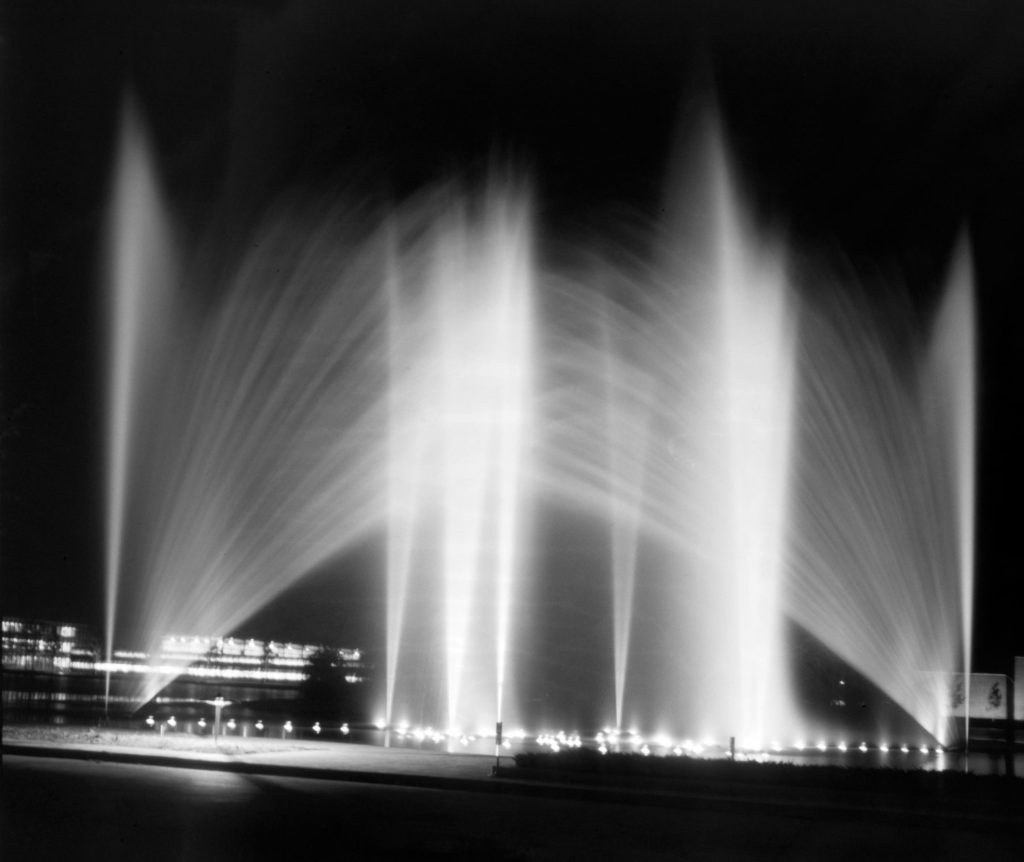
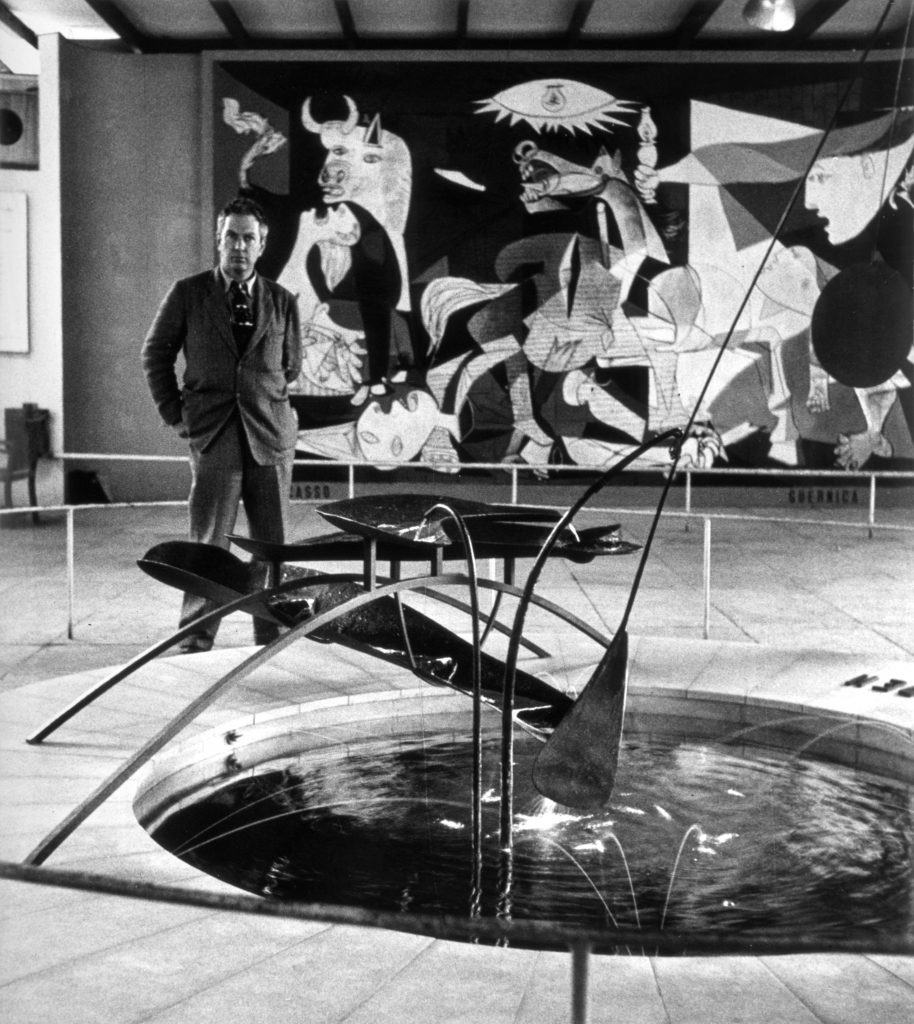
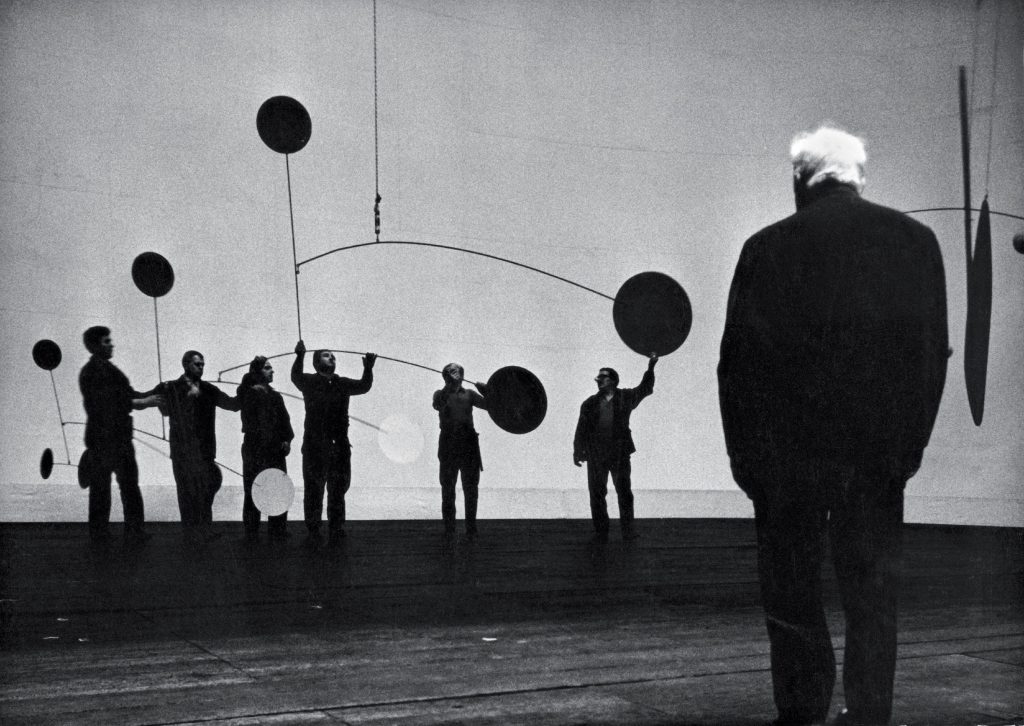
For the 1939 New York World’s Fair, Calder conceived a project for a fountain in the same spirit, though exploiting very different technical means. It was to occupy a very large basin stretching in a quarter circle in front of the Consolidated Edison Building, the work of architects Wallace Harrison and André Fouilhoux. Calder envisioned using waterspouts to create what he described as “a water ballet” in “four movements” in a text that, significantly, was reprinted by Theater Arts, a periodical devoted to the arts of the stage. He used the vocabulary of choreography and stage decor to describe the overall project, strongly emphasizing its relationship to them: “The center of the basin itself acts as the stage for a water ballet whose actors are the jets of water from fourteen spouts designed to shoot up, oscillate, and turn in a specified way and at intervals as carefully predetermined as the movements of real dancers. The ballet is timed to last five minutes, following each time the same format set in advance, with fifteen minutes or more between performances.”[48] In his conception, this Water Ballet was to realize, barely two years after the success of Mercury Fountain (1937, Fondació Joan Miró, Barcelona), some of the artist’s firmest ambitions concerning stage production on a monumental scale. The composition of motion is complex and varied, offering surprises and rebounds in a studied gradation of effects. However, technical problems again apparently made it impossible to execute this fountain, which was replaced by a device with regular spurts rather than a composition of motion. As it turned out, in 1954 Calder saw a project derived from his original idea accepted by Eero Saarinen for the General Motors Technical Center in Warren, near Detroit. This Water Ballet realized his idea of a programmable fountain-ballet; in one movement of the performance, seven water spouts “danced” in a “Ballet of the Seven Sisters,” as Calder called it. The water show was linked, in its own way, to the tradition of baroque water displays, which the world’s fairs had already revived.[49]
Calder, however, had to wait until the end of his life to realize the most ambitious of his goals concerning the staging of movement: his Work in Progress, performed in 1968. It arose from frustration. Although the thirty years following Socrate had been punctuated by about a dozen theater collaborations, his role had never gone beyond contributing what amounted to a stage prop in productions in which he did not control all the elements. One day, perhaps from weariness, Calder turned down an invitation from Massimo Bogianckino, artistic director of Teatro dell’Opera in Rome, for yet another collaboration on the sets for ballets and opera. “For thirty years I have been thinking about a production that would be entirely mine, form and music working together. I long ago discussed this with Massine, but he insisted on having dancers. I later made stage sets, but this is not exactly what I wanted to do … The idea of a production that was totally mine had already come to me in spirit in 1926 when I finished the Cirque, and when I tried to frame it in a stage opening, amusing myself by thinking it an actual theater.”[50] Bogianckino decided to take up the challenge and gave Calder carte blanche, that is, complete control over everything that happened onstage for the performance. The result, Work in Progress, was only nineteen minutes long, with mobiles accompanied by three compositions of electronic music. Its premiere on 11 March 1968 was followed by two more performances.[51] A short time later, Calder wrote to his sister and expressed his satisfaction with the smooth operation of the production and the quality of the technicians placed at his disposal. He then described the inspiration that had guided him, even pinpointing the sources of the work itself: “The idea in general dated from 32 and 33—when we lived in rue de la Colonie, in Paris, XIII [thirteenth arrondissement] about the time I made the first mobiles.”[52]
Work in Progress is in some ways a reflection of its creator’s career: many of the mobiles in the show were enlargements of works that represented different stages in Calder’s development. He seemed to offer a summary, an unfolding résumé. The performance, he said, could have been named “my life in nineteen minutes.”[53] But beyond presenting this parade of his work, Calder sought to present the overall life cycle, from the genesis of stars to the appearance of the earth, animals, and humans. Many mobiles evoked a cosmic or naturalistic symbolism, motifs that were sometimes explicitly clear—a shining sun, silhouetted animals. The production underscored the basis of all Calder’s work, before and after the invention of the mobiles: the exploration of nature, in depth and, most of all, in movement. And if we truly want to view these works with a playful intention and connect them to the world of toys, it does not necessarily mean that we have to view them with the sentiment of a child. Instead, Calder’s works lead us to recall, with Jurgis Baltrusaitis, that since the automatic toys and the moving machines of the baroque, “it has been mechanical toys that have captivated people, that both amused them and led them to meditate on the laws of nature and the contrivances that master them.”[54]
The movement that endows Calder’s works not only relates to the movement of bodies in the natural, real world,[55] but also gives them their theatrical and performance capacities. The mobiles do much more than reflect the natural order, they place before us the spectacle of nature. And if they fulfill so completely the intentions of their creator, it is because they can be seen in the same way that Calder seems to have looked at the world, as a stage—on which phenomena take place and before which people remain—encompassing all the movements of the universe, from the slightest tremblings of nature to the dance of planets.
National Gallery of Art, Washington, D.C. Alexander Calder: 1898–1976. 29 March–12 July 1998.
Solo ExhibitionHauser & Wirth, Los Angeles. Calder: Nonspace. Exhibition catalogue. 2019.
Andrew Berardini, The Cosmic Mathematics of Alexander Calder
Solo Exhibition CatalogueAlmine Rech Gallery, New York. Calder and Picasso. Exhibition catalogue. 2016.
Robert Slifkin, The Mobile Line
Susan Braeuer Dam, Liberating Lines
Jordana Mendelson, Picasso, Miró, and Calder at the 1937 Spanish Pavilion in Paris
Group Exhibition Catalogue“Calder in France.” Cahiers d’Art, no. 1 (2015). Edited by Alexander S. C. Rower.
Susan Braeuer Dam, Calder in France
Robert Melvin Rubin, An Architecture of Making: Saché and Roxbury
Agnès Varda in conversation with Joan Simon
Magazine, MonographMuseo Jumex, Mexico City. Calder: Discipline of the Dance. Exhibition catalogue. 2015.
Alexander S. C. Rower, Calder: Discipline of the Dance
Solo Exhibition Catalogue